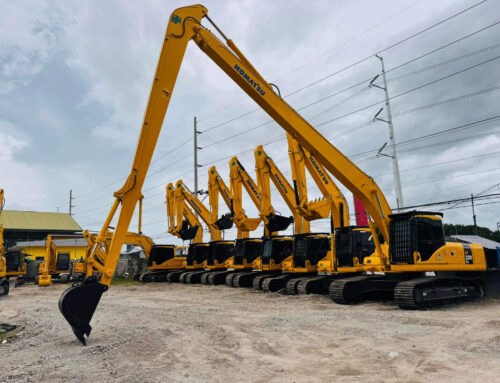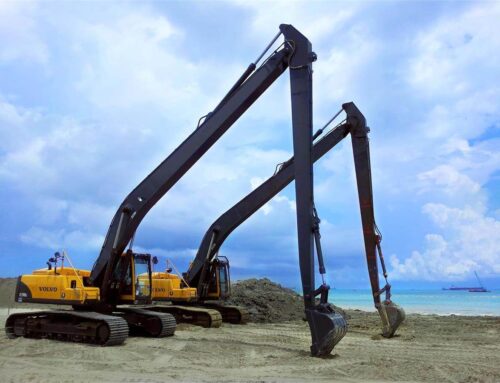Excavators are versatile, heavy-duty machines that play a critical role in construction, demolition, and other industrial projects. Two specialized types of excavator booms—excavator material handling boom and excavator long front boom—are often used for particular tasks, each offering unique benefits and potential limitations. Choosing between these two types of booms depends largely on the specific requirements of the job, including the nature of the material being handled, the height or distance the boom needs to reach, and the working environment.
In this blog post, we’ll dive into the advantages and disadvantages of excavator material handling booms and excavator long front booms, while also exploring their key differences and how these distinctions impact various projects.
What is an Excavator Material Handling Boom?
A material handling boom is a specialized type of excavator attachment designed specifically for handling bulk materials, particularly in scrapyards, waste management facilities, and industrial ports. Unlike the typical digging or trenching booms, material handling booms are optimized for lifting, moving, and placing large quantities of materials with precision and efficiency. These booms can often be outfitted with a claw, grapple, or bucket to aid in material handling.
Advantages of Excavator Material Handling Booms
-
Increased Precision and Control
Material handling booms are designed with a focus on control, which allows operators to move large amounts of material with great accuracy. Whether moving scrap metal or handling recyclables in a waste management facility, these booms provide a level of precision that traditional digging booms cannot.
-
Enhanced Load Capacity
Material handling booms are built to handle large loads with ease. Their structural integrity allows them to lift and move heavy objects such as containers, scrap metal, and waste products in a way that a standard boom might struggle with. They’re optimized for lifting power rather than digging force.
-
360-Degree Rotational Capability
One major feature of material handling booms is their ability to rotate 360 degrees. This allows operators to quickly maneuver materials to different locations without needing to reposition the excavator, leading to improved operational efficiency.
-
Versatility in Industrial and Port Operations
These booms excel in situations where large amounts of material need to be transported and sorted in quick succession. They are commonly used in port terminals, rail yards, and industrial recycling centers, making them essential for projects involving high-volume material movement.
Disadvantages of Excavator Material Handling Booms
-
Limited Reach
While excavator material handling booms are optimized for precision and lifting heavy objects, they often have a shorter reach compared to long front booms. This makes them less suitable for tasks that require reaching over long distances, such as excavating from deep pits or clearing debris from a distance.
-
Specialized Use
These booms are highly specialized for material handling, which can limit their versatility on the job site. For projects requiring excavation, trenching, or demolition work, a material handling boom would not be the ideal choice. The narrow scope of their design may require switching to other equipment to complete various phases of a project.
-
Less Suitable for Excavation Tasks
Since they are designed for lifting and moving, material handling booms lack the digging force and articulation necessary for more traditional excavation tasks. Their shape and design are not built to penetrate the ground or handle heavy-duty trenching work.
What is an Excavator Long Front Boom?
A long front boom, also known as a long-reach boom, is an excavator attachment designed for tasks that require extended reach and depth. These booms are ideal for projects such as dredging, deep excavation, demolition at a distance, and riverbank stabilization. The extended length of the boom allows operators to reach areas that would be impossible for a standard boom to access.
Advantages of Excavator Long Front Booms
-
Extended Reach
The primary advantage of a long front boom is its extended reach, which can span up to 20 meters or more, depending on the excavator model. This makes it ideal for projects that require working at a long distance from the base of the machine, such as dredging rivers, excavating deep trenches, or reaching across large spaces.
-
Versatility in Excavation and Demolition
Long front booms are versatile in handling different types of projects. They are widely used in demolition work, especially when the structure is tall or delicate. The extended reach allows operators to safely work on structures from a distance, reducing the risk of damage to the excavator or harm to the operator.
-
Improved Efficiency in Dredging and Deep Excavation
Long front booms are particularly valuable in projects involving dredging or deep excavation. The boom’s extended length makes it possible to dig in hard-to-reach places, such as below water surfaces or into deep foundations, where standard booms cannot reach.
-
Enhanced Safety in Hazardous Environments
In projects where the surrounding environment poses a danger, such as near collapsing structures or when handling hazardous materials, long front booms allow operators to keep a safe distance from potential hazards, thereby increasing safety.
Disadvantages of Excavator Long Front Booms
-
Reduced Lifting Capacity
While long front booms excel in reach, they often have a lower lifting capacity compared to material handling booms. The extended arm means that the weight distribution changes, and the excavator may struggle with lifting heavy loads at maximum reach. This can be limiting in projects that require both reach and heavy lifting capability.
-
Decreased Precision
Long front booms offer greater reach, but their precision and maneuverability tend to suffer as a result. The further an operator reaches with the boom, the harder it becomes to control fine movements. This makes them less ideal for projects requiring precise material placement or handling.
-
Limited Application
Long front booms are highly specialized for excavation and demolition at a distance, making them less useful in close-range work or tasks that require heavy lifting. They are not suited for indoor projects, scrapyard work, or any project requiring detailed material handling.
-
More Difficult Transportation and Storage
Due to the sheer length of long front booms, transportation and storage can be more complex and expensive. Their size may require special transport vehicles, and they often need more space on-site, which can be a challenge in crowded urban areas.
Key Differences Between Excavator Material Handling Boom and Long Front Boom
Primary Function: Material handling booms are designed for lifting and moving heavy materials, while long front booms are optimized for reaching distant or deep areas during excavation or demolition.
Reach vs. Lifting Power: Material handling booms prioritize lifting capacity and precision, whereas long front booms offer extended reach but sacrifice some lifting power and precision.
Operational Environment: Material handling booms excel in industrial and recycling settings where materials need to be moved efficiently, while long front booms are more suitable for demolition and deep excavation tasks in construction projects.
Specialization: Material handling booms are specialized for sorting and placing materials, while long front booms are specialized for reach-intensive tasks like dredging or demolition at height.
Transport and Setup: Long front booms are generally more cumbersome to transport and set up due to their length, whereas material handling booms are easier to move and store.
Conclusion: Choosing the Right Boom for Your Project
Both material handling booms and long front booms serve distinct purposes and excel in their respective areas of operation. Material handling booms are the go-to option for high-volume material movement in industrial environments, offering precision and lifting power. In contrast, long front booms provide the extended reach needed for dredging, deep excavation, and demolition projects where distance is key.
Ultimately, the right choice depends on the specific needs of the project. For jobs requiring extensive reach, such as deep excavation or high-rise demolition, the long front boom is indispensable. However, if the project requires lifting and placing heavy materials with precision in a confined area, a material handling boom would be the better option.
Understanding the strengths and limitations of both types of booms will help project managers and operators select the right tool for the job, ensuring efficiency, safety, and cost-effectiveness.








Leave A Comment